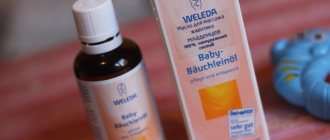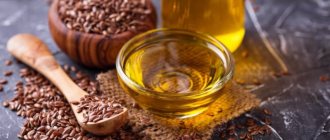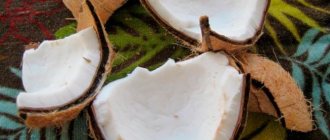A man is born! How much this event means in the life of a young family: happiness, pleasant chores, responsibility for the life and well-being of the baby. Properly organized nutrition for your baby is the key to his health. In this regard, the first five months of a little person’s life do not burden the mother with any worries: breast milk is enough for the child’s body to receive all the necessary nutrients. From the sixth month, vegetable and fruit purees, as well as cereals, are introduced into the child’s diet. According to the recommendations of pediatricians, from the age of 7 months, the baby’s food is enriched by the introduction of vegetable oil into the diet; a month later, his feast is replenished with meat, bread, juice and butter.
As you can see, vegetable oils become a necessary attribute of a child’s diet quite early. Why do these products play such an important role? This is due to the fact that the intensive development of the body begins to lack the beneficial substances that make up breast milk, while vegetable oils contain vitamins, fatty acids, and in some cases antibacterial properties .
A Brief Overview of Some Vegetable Oils
Even 20 years ago, the question of what kind of vegetable oil to introduce into the diet of newborns did not arise: there was no alternative to sunflower oil in our country. Now, in the desire to make the right choice for the health of the baby, the mother has to arm herself with a lot of knowledge in order to give preference to one of the many plant products: walnut oil, sesame oil, sunflower oil, rapeseed oil, corn oil, pumpkin oil, flaxseed oil, olive oil or soybean oil.
To make life easier for young mothers, we analyzed the beneficial properties of vegetable oils most often included in complementary foods.
Sunflower (unrefined)
- Well absorbed by the child's body;
- serves as a source of vitamins E, A and D (this vitamin is necessary for the prevention of rickets in children under 2 years of age);
- contains polyunsaturated fatty acids, which has a beneficial effect on brain function, the body's metabolic processes, and the functioning of the visual and nervous systems.
When included in the diet in the amounts recommended by pediatricians, it has no negative consequences.
Linen
- Polyunsaturated fatty acids and fat-soluble vitamins contained in the product stimulate brain function and are beneficial for the digestive tract;
- is a good preventative against constipation and helminthic infestations.
Disadvantage: the bitter taste inherent in the product makes it difficult to include it in the children's diet.
Corn
- Contains vitamins B1, B2, PP, K3;
- Due to the high concentration of vitamin E, it normalizes the functioning of the thyroid gland, endocrine system and adrenal glands.
Mustard
- Contains vitamins E (necessary for good immunity) and D (for the prevention of rickets);
- the substances included in the product have antibacterial properties.
Olive
This product, according to nutritionists and pediatricians, is ideal for complementary feeding. The secret of such unanimity lies in the fact that the product is easily absorbed by the body, because the polyunsaturated fatty acids that make up olive oil are as close as possible to breast milk in percentage terms. Let's talk about the composition and beneficial properties of this product.
Corn oil
When to introduce complementary foods: from 7 months.
Which one to choose: unrefined.
Corn oil is useful for its content of vitamins: E, A, B1, B2, PP, F, as well as minerals such as iron, magnesium, potassium. It contains many unsaturated acids that are beneficial to the body: linoleic, oleic, stearic, palmitic. And when heated, almost all the beneficial properties of the oil remain.
Corn oil is obtained from the germ of corn. It is the most useful and is a transparent, odorless composition, similar in composition to sunflower. The biggest advantage is that it does not form carcinogens. Therefore, it is optimal for frying. In addition, it does not foam and does not burn.
On sale you can only find refined corn oil. It has a stimulating, softening and nourishing effect on the body, effectively improves immunity and clears excess cholesterol. This is a dietary product with a high content of vitamin E, which heals the body, strengthens muscles and prevents excess weight.
Palm oil today is often included in infant formula. Many people consider this product harmful. However, in purified form and as an additive to children's products, it becomes natural and safe. How to choose the right formula for your child, see.
Palm product has a positive effect on the functioning of the colon, promotes the processing and removal of toxins, bile acids, harmful and dangerous substances. But consuming palm oil separately is not recommended. In addition, it is only suitable for frying.
Composition and properties
Olive oil contains:
- vitamins (A, D, E, K);
- mono-unsaturated fatty acids (oleic acid, linoleic, palmitic, peanut);
- compounds (phenols and polyphenols, tocopherols, sterols, terpene alcohols).
From the point of view of the average person, this information gives nothing to people who are far from knowledge of chemistry. To reveal the meaning of the product, we present a table that clearly reflects its beneficial properties.
| The name of the body system or organ of the child that olive oil can affect | Beneficial properties and (or) method of action of the oil |
| Skeletal system | Taking the product stimulates the absorption of calcium by the body, due to which the bone skeleton is strengthened |
| The immune system | The phenols included in the product serve as a source of strengthening the immune system |
| Visual system | Linoleic acid has a positive effect on vision (in addition, it has a positive effect on the regenerative properties of the body in healing wounds and other injuries) |
| Endocrine system | Acts as a prophylactic agent, preventing the occurrence of diabetes mellitus, improves metabolic processes in the body. In addition, by including a maximum of healthy fats, the product is able to remove harmful fats from the body. |
| Digestive system | Prevents constipation, has a mild laxative and choleretic effect |
| Nervous system | The complex of fatty acids included in the product has a beneficial effect on the baby’s nervous system and brain function. |
| Skin | The cause of many skin diseases in newborns is a lack of linoleic acid. Replenishment of this ingredient, contained in large quantities in the product, provides significant support in getting rid of skin ailments |
When can you give olive oil to babies?
Olive oil is quite a heavy product for small children, as it contains a lot of fatty acids. Many pediatricians claim that starting from 7 months, when the baby is eating vegetable purees and cereals in full swing, you can add a drop of olive oil (about 1 g) to them. Previously, vegetable oil should be administered if the baby is not gaining weight well, but such a decision should be made exclusively by the doctor.
It is olive oil that should be preferred, since of all types of vegetable oils it is best absorbed and is considered the most useful due to the content of fat-soluble vitamins A, E and D. Many pediatricians claim that olive oil contains the same amount of fatty acids as breast oil, because The first acquaintance with oils should begin with this product.
Olive oil can also be added to salads for infants; for example, from the age of six months, children can make salads from carrots, beets and potatoes. At seven months, you can add other vegetables to this salad, as well as olive oil, which will make it more tasty and nutritious. Homemade meat and fish pates will also be more to the baby's taste if a little olive oil is added to them.
You should not add oil to store-bought baby food - canned meat, broccoli and pumpkin puree, since they already contain vegetable oil to make the puree more tasty and absorbed faster. By 8 months, the norm for oil consumption is 3 g, and by 1.5 years – 5 g.
Methods of application
External use
For constipation
Olive oil is an effective remedy for constipation and can be used even for newborns. A few drops at room temperature are applied to the baby’s belly and the tummy is massaged with gentle movements. With this method of application, the substances responsible for the laxative effect contained in the product are literally absorbed by the baby’s skin and delivered to the digestive organs.
To distribute the active substances of the product more evenly, you can use another method other than massage: in this case, the mother presses the baby’s tummy to her body.
For diaper rash
Diaper rash is the most common problem in newborns. To get rid of them, the baby’s damaged skin is treated with sterilized olive oil 3-5 times a day. The temperature of the product is important - about 20 degrees. Olive oil does not clog the pores of baby's skin, so there is no need to wipe it off.
Another option for using oil is possible. It is mixed with water in a 1:2 ratio, then used in the same way as in its pure form.
For diathesis
Olive oil and fir oil, mixed in a ratio of 3 tablespoons to one, with the addition of vitamin C (2 drops), become a remedy that helps get rid of the scourge. The mixture is applied to the affected areas of the skin 3 times a day.
To treat the disease, a tincture is also used, which is prepared from 100 ml of oil and crushed St. John's wort flowers (2 handfuls). The mixture is infused for a week in a dark, warm place, after which it is used in the same way as in the previous case.
For the treatment of wounds and scratches
To quickly get rid of scratches, it is enough to apply a napkin soaked in sterilized olive oil to them a couple of times a day. In case of more serious skin damage (wound), a special ointment is prepared: olive oil (two parts) is brought to a boil over low heat with one part beeswax. After cooling, the mixture is ready for use.
Internal use
For constipation
There are several ways to solve this problem; the choice of solution depends on the age of the baby.
If we are talking about a newborn, the mother lubricates the nipple with olive oil before feeding. If the child has already celebrated the first half of the year, a drop of the product is dripped onto his tongue. If the baby receives complementary foods and has crossed the threshold of one year, then the volume of the product used is a quarter of a teaspoon for every 60 grams of food. In some sources you can find references to enemas using olive oil. Meanwhile, according to pediatricians, children under 2 years of age are not recommended to have enemas, especially oil ones. They resort to this method in exceptional cases under the supervision of a doctor, when nothing else helps to get rid of constipation.
For coughs and colds
For children over one year old, when coughing (including whooping cough), give honey mixed with warm olive oil in a 1:1 ratio. Frequency of administration: 3 times a day, a teaspoon.
For colds, a simpler recipe for using the oil is practiced: it is taken in its pure form three times a day, one teaspoon. The effectiveness of the product is due to its immuno-strengthening properties (and in case of sore throat or spasmodic cough, the effect of softening an irritated throat is also added).
Application in massage
Olive oil is great for massage . Rules for use during massage:
- before the massage, if the product was stored in the refrigerator, you need to measure out the required amount, pour it into another bottle and heat it in a water bath;
- It is not recommended to massage the face (may get into the eyes);
- there is no need to actively rub the baby’s skin; it is recommended to massage the baby’s body lightly, making circular movements, patting or stroking with your palm and fingers;
- After the procedure, you should wrap the baby in a diaper so that the oil is completely absorbed into the skin.
Step-by-step instruction:
- Place a bottle of olive oil, wet wipes, and a towel next to the massage area.
- Remove foreign objects from your hands: rings and bracelets.
- Warm your hands.
- Apply a few drops to them.
- Wait until the oil warms up from your hands before touching the child.
- Carry out the procedure, periodically adding the product to your hands.
- After the massage, do not wipe the baby, wrap it in a diaper and hold it in your arms for a while.
We recommend watching a video about using olive oil to massage your baby:
Supplementing your baby's diet with olive oil
Olive oil is introduced into the baby’s diet from 7 months of age. Initially, the daily dose is only 1 ml, at the age of 8 months it increases to 3 ml. From 9 months to one year, the daily need for the product is estimated at 5 ml.
The product is not given to the child in its pure form; vegetable puree is diluted with it. To flavor the porridge, they use butter rather than vegetable oil.
As children grow older, olive oil takes an even stronger place in the diet (after all, food becomes more varied, for example, salads made from raw vegetables seasoned with olive oil appear).
Olive oil is harmful for babies
Despite the great benefits for children's health, olive oil can be harmful to the child's body. Since it is known that olive oil has a strong choleretic effect , the amount of product consumed should be strictly controlled.
In no case should you give food that has been heated in olive oil, since during heating all beneficial substances are destroyed, and carcinogens are formed in it, which can greatly harm the child’s health.
Choose and not make a mistake
The quality of olive oil directly depends on the method in which it is obtained. The best extra-class product has the designation Extra virgin olive oil on the label ; it is obtained without the use of chemicals from good quality olives through the first cold pressing.
This product is expensive. The second cold pressing is a method of obtaining a product of a lower class; accordingly, the word Extra disappears on the label, leaving only Virgin olive oil. All subsequent manufacturing technologies involve the use of chemicals. The pomace oils resulting from this technology may have different designations: Pureoliveoil, Pomaceoil or Oliveoil. The product we are interested in is produced in Africa (Tunisia, Libya, Algeria), the Middle East (Syria, Turkey) and southern Europe (Spain, Italy, Greece). Production volumes vary somewhat, but if we are talking about a product for children, it is worth paying attention to Greece, since it is in this country that 80% of the total production volume corresponds to top-class quality.
It should be noted that on the shelves of modern stores you can sometimes find bottles of olive oil labeled “special for children,” but an analysis of the composition and method of manufacturing the product shows that these are ordinary unrefined, cold-pressed oils (extra-class quality). For children, it is better to choose organic oils, which means that the olives have not been treated with pesticides, herbicides or chemical fertilizers!
Top 8 proven olive oils:
- Spectrum Naturals Organic, Cold Pressed, Edible
- Bionaturae, organic, virgin, edible
- La Tourangelle, organic, cold pressed, can be used for food
- Now Foods organic, virgin, edible
- Flora organic, edible, first pressed
- Kevala organic extra virgin (cold pressed), suitable for food
- California Olive Ranch, not organic, but cold pressed, good for eating
- Gaea, not organic, but cold-pressed, can be ingested
Reviews
Turning to the reviews of mothers left on social networks, we can draw the following conclusions:
- the number of reviews left is small (this fact can be attributed to the busyness of young mothers);
- most of the reviews are somehow related to the high cost of the product;
- Using the product, mothers note its high taste characteristics, as well as its effective properties for treating constipation in children;
- the problem of using the product to treat coughs, colds and other diseases is not taken seriously.
Summing up the results of the study of the effects of olive oil on the child’s body, we can conclude that the only contraindication for including this product in the baby’s diet is allergies . Nutrients, medicinal and beneficial substances included in the product make it an indispensable ingredient in the children's menu.
At what age can you give vegetable oil to a child?
- Contains healthy fatty acids, vitamins and minerals.
- It is very important to introduce such a product into the baby’s diet, but in small portions.
- Vegetable oils have a positive effect on the visual organs, nervous and cardiovascular systems, as well as the digestive organs.
- Good to add to salads or soups.
- For children under one year old, it is better to purchase refined oils; they are purified and are safer and less allergenic for the baby.
- Fried foods should not be in the diet of a child up to a year, or better yet, up to two.
There are several types of vegetable oil, each of which has its own value.
1. Sunflower oil contains vitamin E and Omega-6 acids.
2. Corn oil has the same properties as sunflower oil.
3. Olive oil is considered the most easily digestible. In addition, it has the longest shelf life because it contains many antioxidants. This oil must be included in a child’s diet, as it helps to increase metabolism and strengthens the cardiovascular and genitourinary systems.
4. Flaxseed oil contains Omega-3 acids. This oil stabilizes the functioning of the child’s intestines, and also strengthens the immune system, has a beneficial effect on the skin and has a laxative property.
Experts say that vegetable oil can be introduced into a baby’s diet starting from the age of five months. First, you need to add 1-2 drops to your diet. At the same time, be sure to pay attention to how the child’s body reacts to this. If no allergic reactions appear, gradually increase the dose of oil so that by the age of one year the little one consumes about 3-5 grams per day.











